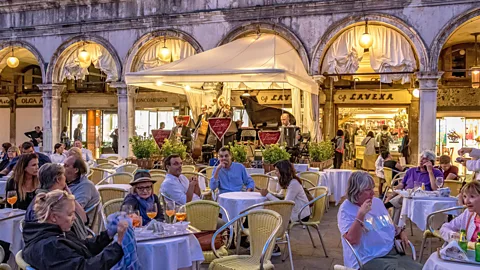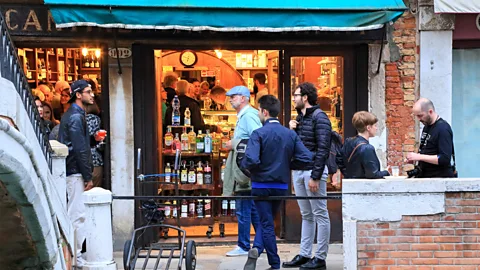Why Aperol Spritz is the drink of the summer
 kkshepel/Getty Images
kkshepel/Getty ImagesThe new popularity of Aperol is leaving some Venetians perplexed. How has a drink that, until 20 years ago could only be found in humble taverns and bars, conquered the world?
This summer, Aperol Spritz has been flowing from the counters of the most enchanting venues in New York City, from the rooftop of the Independent Art Fair in Tribeca to the flamingo-themed new bakery on my Brooklyn block. In Singapore, you can take an Aperol Spritz bar crawl, and in Paris, it's now a fixture at most cafes next to the local pastis and kir.
It seems that aperitivo (Italy's cherished pre-dinner drink) has become the new happy hour. And yet, the current popularity of Aperol Spritz leaves us Venetians slightly perplexed. How did a drink that, until 20 years ago could only be found in our region's humble osteria (tavern) and cheap local bars, conquer the world?
Concocted in about three minutes with half a glass of prosecco, a third glass of bitter liqueur, ice cubes and a splash of seltzer – added in this order, so that the bubbles naturally burble up – and garnished with a big, juicy olive or an orange slice, the Venetian aperitivo was recently voted Italy's favourite pre-dinner drink. It is so popular that Italian minister Eugenia Roccella deemed it responsible for a population crisis saying that young couples now choose between "drinking spritz and having kids". In the US, it's become so fashionable that Star Wars actress Zendaya, among others, wears Aperol Spritz-coloured nail polish inspired by the summery orange hue of the drink.
Other spritz liqueurs
In 1920, brothers Mario and Vittorio Pilla boiled, mashed and distilled 30 aromatic herbs over a period of nine months in Venice and created the drier Select. Campari, also the base of iconic Negroni drinks, with its distinctive floral and orange notes, was invented in 1860 at Gaspare Campari's bar in Novara, not far from Milan. And finally, the most bitter of all: artichoke-based Cynar, was conceived by Venetian entrepreneur Angelo Dalle Molle in a Padova distillery in 1948.
The original spritz wasn't orange though. Its history goes back to the 19th Century when Austria occupied Venice in 1797 and ruled it for decades; the Austrians had no taste for the heavy Venetian wine, Malvasia, and imported their tradition of "Spritzen", adding a splash of sparkling water to a glass of white wine. The idea to use the local sparkler, prosecco, instead of wine and mix it with a bitter liqueur came much later, when, according to Giuseppe Zanon, bartender and co-owner of the historic Al Mercà café (Campo Bella Vienna, 213) by the Rialto Bridge, Venetians decided that watered-down wine was too light and started to add Aperol, Select, Campari or Cynar (listed in order of sweetest to most bitter).
Aperol – now by far the most popular spritz liqueur around the world – was invented in the nearby city of Padova in 1919 by brothers Luigi and Silvio Barbieri after seven years of experiments, macerating sour orange peels, gentian root, rhubarb and spices in their father's distillery. It was first d in the 1920s to drinkers who wanted to stay fit because of its low alcohol level (11%), and to women in the 1930s with the slogan, "Signora! Aperol keeps you thin". By the '80s, it was dirt-cheap and appreciated by regulars at every local bar in the Veneto region, creating a sort of spritz archipelago in the Po Valley, where the cities of Padova, Venice, Treviso and Vicenza would carry on the tradition, each with their own slightly different recipe.
"Aperol Spritz was the drink of the old salts and the old drunks, the ones at the bar who (I say this with the deepest affection) would say a curse every three words," explained Roberto Pasini, author of the 2013 pamphlet A Guide to Spritz. It was served in sturdy rock tumblers, "which were indestructible and could be slammed downon the counter of the osteria".
 teve Tulley/Alamy
teve Tulley/AlamyRowdy old men, however, were not the only ones to see the appeal of the cheap and cheerful drink. By the late '90s, Padova's medieval squares and the cobblestoned backstreets of its ancient ghetto were crowded every Friday evening with rambunctious students enjoying Aperol or Campari spritzes in plastic cups with their friends. It was an excuse to meet people and stay out late, with the olive garnish often standing in for dinner.
In his song Fame un Spritz (Make Me a Spritz), Sir Oliver Skardy, whom I can only describe as our Venetian Bob Marley, portrayed the osteria as a "real oasis" in the sticky heat of the Venetian summer, where students and grandpas alike would play cards, eat, drink and carouse together.
To ensure it controlled the Venetian market, Campari bought Aperol in 2003. It also brought this regional aperitivo to few selected bars in Milan and, in a true stroke of design genius, started serving it in an elegant and tall balloon-shaped glass instead of the rock tumbler of the osteria.
 Matthias Scholz/Alamy
Matthias Scholz/Alamy"A brave choice, but rather annoying", said Julka Villa, a Veneto native and CMO of the Campari Group, who shared my own averse reaction when she first saw the new glass in bars 20 years ago. But while it looked unnatural, a sort of Milan-isation of a down-home Venetian tradition, it was also a clever, game-changing commercial choice.
"This glass gave it visibility and dignity," said Villa. The glass signified the drink's elevation from the humble osteria to the upper-class bar lounge. The target drinker was no longer the old "medieval barfly" of Padova, who would order it from 12th-Century watering holes, but the aspirational and fashion-conscious crowd of Milan. Glasses no longer needed to be sturdy because no one slammed them on the counter anymore.
Skardy lamented that "spritz used to be cheap, [and] now it's a luxury for yuppies". But nothing could stop the rise of Aperol, a sort of orange tidal wave that, according to food expert Eleonora Cozzella, was powered by the easy appeal of its colour and taste. "It has a chromatic coherence: it's the colour of the summer evening. You say Aperol Spritz, and you already see yourself on a terrace at sunset overlooking the Adriatic Sea," she explained. (It's such a distinctive hue that Pasini is creating a pantone colour chart for beginner mixologists who want to get the right tone).
"It's sweet, but people can also enjoy the aromatic flavour, the herbs and the citrus," continued Cozzella. "And who doesn't like prosecco and the orange">window._taboola = window._taboola || []; _taboola.push({ mode: 'alternating-thumbnails-a', container: 'taboola-below-article', placement: 'Below Article', target_type: 'mix' });
